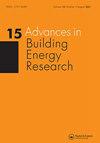Guest Editors’ Preface (Special issue “A Paradigm Shift in Integrated Building Design - Towards Dynamically Operated Buildings”)
IF 2.5
Q2 CONSTRUCTION & BUILDING TECHNOLOGY
引用次数: 1
Abstract
The primary function of the building has not been changed through the whole history of mankind – to provide shelter from the exterior conditions and provide the environmental control for comfort and health of the occupants. Despite the fact of having the same function, the requirements on building design are constantly increasing (high energy performance, airtightness, resource efficiency, healthy indoor climate, different aspect of indoor comfort – hygrothermal, visual and acoustic; etc.) making the building a highly complex system (building envelope, technical and service systems, automatization and control systems, interaction with occupants). In traditional approach, buildings were designed to meet certain, usually predefined, criteria of function and comfort, regardless of how they fit with the natural (local) surrounding. In this prescriptive design approach, buildings were designed and constructed for current conditions as ‘static’ structures isolated from their environment and the occupant. A paradigm shift in the integrated design implies changing the traditional design principles that are rooted in our codes and standards. We believe that the prescriptive thinking should be left in the past. A paradigm shift implies understanding that each building is a ‘dynamic’ system responding to, both outdoor and indoor climates. This new design paradigm is striving for a good indoor environment and high energy performance of building by interacting with the local climatic conditions and requirements of its use. At the same time, impact of building on the environment and its operating costs during the whole life cycle are taken into account, whereby durability of construction materials, building envelope systems, technical systems and building as a whole are put into focus. Performance-based design, that considers environmental, economic and social aspects, is in line with principles of sustainable development and thus, sustainability has become one of inevitable paradigms of integrated building design. New innovative technologies are constantly emerging, but they need to remain in the wellknown triangle technology-people-process, which means that integration of innovative technologies and strategies in buildings is good only if they are useful to the occupants, i.e. they are useful only if occupants are capable of using it. The paradigm shift towards integrated building design, also progressing towards dynamically operated buildings, facilitates integration of different professions in both design and construction. The interaction between different disciplines, high level of expertise and awareness are playing the key role. The importance of experience gained from previous failures has become crucial, especially when embracing digitalization and industry 4.0 in building design and construction. Many of the issues in building science, in context of energy efficiency, ecology, economy and social values as integral part of sustainability, have been addressed by papers presented客座编辑前言(特刊“综合建筑设计的范式转变——迈向动态运作的建筑”)
在整个人类历史中,建筑的主要功能没有改变——为居住者提供躲避外部条件的住所,并为居住者的舒适和健康提供环境控制。尽管具有相同功能,对建筑设计的要求不断提高(高能源性能、气密性、资源效率、健康的室内气候、室内舒适性的不同方面——湿热、视觉和声学等),使建筑成为一个高度复杂的系统(建筑围护结构、技术和服务系统、自动化和控制系统、与居住者的互动)。在传统方法中,建筑的设计是为了满足某些(通常是预定义的)功能和舒适性标准,无论它们如何与自然(局部)环境相适应。在这种规定性的设计方法中,建筑物是根据当前条件设计和建造的,是与环境和居住者隔离的“静态”结构。集成设计的范式转变意味着改变植根于我们规范和标准的传统设计原则。我们认为,规定性思维应该留在过去。范式的转变意味着理解每栋建筑都是一个“动态”系统,对室外和室内气候都有反应。这种新的设计模式通过与当地气候条件和使用要求的互动,努力创造良好的室内环境和建筑的高能源性能。同时,考虑到建筑在整个生命周期内对环境的影响及其运营成本,从而关注建筑材料、建筑围护系统、技术系统和整个建筑的耐久性。基于性能的设计考虑了环境、经济和社会方面的因素,符合可持续发展的原则,因此,可持续性已成为综合建筑设计的必然范式之一。新的创新技术不断涌现,但它们需要保持在众所周知的三角技术-人的过程中,这意味着只有当创新技术和策略对居住者有用时,即只有居住者能够使用时,创新技术和战略在建筑中的集成才是好的,也在向动态运行的建筑发展,促进了不同专业在设计和施工方面的整合。不同学科之间的互动、高水平的专业知识和意识发挥着关键作用。从以前的失败中获得的经验的重要性变得至关重要,尤其是在建筑设计和施工中采用数字化和工业4.0时。建筑科学中的许多问题,在能源效率、生态、经济和社会价值观作为可持续发展的组成部分的背景下,已经在提交的论文中得到了解决
本文章由计算机程序翻译,如有差异,请以英文原文为准。
求助全文
约1分钟内获得全文
求助全文
来源期刊

Advances in Building Energy Research
CONSTRUCTION & BUILDING TECHNOLOGY-
CiteScore
4.80
自引率
5.00%
发文量
11
 求助内容:
求助内容: 应助结果提醒方式:
应助结果提醒方式:


